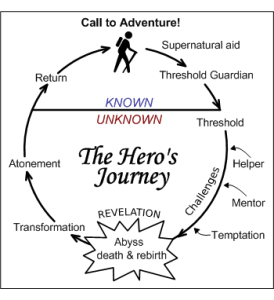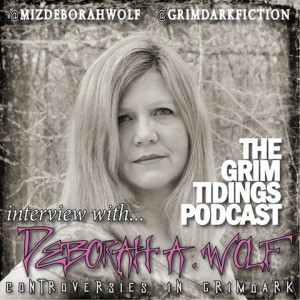Most of you who are writers have probably already heard about the Hero’s Journey. Described by Joseph Campbell in The Hero With a Thousand Faces (1949), The Hero’s Journey—or monomyth—is a basic pattern that can be found in stories and legends around the world:

The Hero’s Journey
The Journey can be broken down into four stages. In Stage 1, the Hero leaves the familiar world behind. In Stage 2, the Hero learns to survive in a strange new world. In Stage 3, the Hero uses this new knowledge to master the unknown world, and in Stage 4 the Hero returns to the familiar world, having gained some necessary bit of knowledge or shiny object.
This is an oversimplification of a very complex and fascinating topic. I would encourage you, especially if you are a writer, to read further here:
http://tvtropes.org/pmwiki/pmwiki.php/Main/TheHerosJourney
And here:
http://www.jcf.org/new/index.php
And here:
http://www.thewritersjourney.com/hero’s_journey.htm
Consider this your Call to Adventure.
I’ve spent a lot of time geeking out about the Hero’s Journey, because storytelling is kind of my thing. If writing is an adventure—and believe me, writing is an adventure—I feel like I’m at stage 2.5. I’ve almost got the hang of this strange new world and I’m getting to the point where I don’t cut myself with my own sword too often. And I’d like to share some thoughts on the Hero’s Journey in storytelling.
I sat down one day and made a Hero’s Journey spreadsheet, and broke down parts of the story lines of JRR Tolkien’s Lord of the Rings, Robert Jordan’s Eye of the World, and George RR Martin’s Game of Thrones.
This is what I do in my spare time. Don’t judge me.
When I did this, I noticed something interesting.
In each story, the Call to Adventure was precipitated by an unlooked-for and somewhat unwanted visitor. Here we have a protagonist, our will-be Hero, happily smoking a pipe, helping Dad with farmboy chores, or lopping off the head of a deserter—Familiar World stuff—when along comes a Sage with some bit of news. Grab your boots and walking-stick, it’s time for an adventure.
What I found interesting was the thought that this Sage—who may become a mentor or helper character in the not too distant future—is an unwelcome visitor. Of course the Call to Adventure is often resisted at first, because who wants to leave a nice Hobbit-hole and a larder full of cheese and bacon? But the Hero’s initial reaction to the person initiating the call is worth examining further. This visitor is often seen as a helper or mentor character, but I would argue that this is also an antagonist.
I began to call this character the Fey Visitor. There’s something otherworldly, powerful, and vaguely frightening about this person. This visitor is viewed with suspicion and unease, and a general wish that they would just go away and leave the Hero in peace.
Of course, the Fey Visitor is a herald to another character or group of characters—Nazgul, Myrdraal, or Lannisters—and this visitor is a direct threat to our Hero’s safety, to the extent that the Hero will be forced to embark upon the journey, and may also be forced to rely upon the Fey Visitor’s strange powers for survival.
I call this second visitor the Fell Visitor, and see it as a dark-mirror image of the Fey Visitor. It seems to me that a story may be enhanced and deepened if the storyteller keeps these two Visitors in mind, plays them off against one another, and has fun comparing and contrasting them as two sides of the same coin. Moiraine and the Myrddraal, King Robert Bareatheon and Cersei Lannister, Gandalf and the Nazgul. Someone who wants you to move and change, and someone else who will kill you if you don’t.
As the Hero continues into the strange new world, eventually lessons will be learned and skills gained that will enable the Hero to overpower either of these antagonists, but for now I will leave Frodo trembling in fear as he agrees to this impossible task, when all he really wants to do is go home, have a smoke, and sit down to a nice little dinner.
Jai to wai,
Debi


Knee to the Face
Chuck Wendig’s blog post on defending the inclusion of *that rape scene* is spot on, and much more gentlemanly than my own response, which is a knee to the face. Because, you know, knee-jerk feminist alarmists
Chuck Wendig’s Gentlemanly Post: YOUR DEFENSE OF THAT RAPE SCENE MAKES YOU SOUND KINDA GROSS
“You’re just mad because a character you like had a bad day!”
The backlash isn’t about the use of rape in a single scene in a single episode of a single show, any more than the Ferguson riots were about a single incident of police brutality. It’s about a pattern of using rape scenes as a go-to plot device. It’s not about “Oh no, Sansa got raped!” so much as “Seriously, another rape? Can’t you show us anything else?”
Also, I don’t like Sansa. I find her vapid.
Also, being raped is not like stubbing a toe, so let’s not treat it in such a cavalier manner.
“Oh, but they lopped Theon’s dick off!”
Yes, and if they had also lopped off the weiners of Robert, Ned, Littlefinger, Jaime, Tyrion, Sam, and the Hound, you’d probably think that was excessive. You’d start wondering whether the writers hated men or something…or maybe they just like to watch weiner-lopping.
“Historical accuracy! Women got raped!”
If you’re going for historical accuracy in a medieval setting, you should have fewer full sets of even white teeth. Perhaps instead of rape, you should have half your cast die of typhus. But that would feel odd, wouldn’t it? Having the same thing happen over and over again to a bunch of different characters, for no apparent reason?
Also, this is fiction, stupid. Anything that happens in a fictional world is a choice made by that world’s creator or creators…unless Annie Wilkes is standing over you with a mallet. And I’m thinking that if Annie Wilkes was standing over you with a mallet, you’d find something besides rape to write about.
“They burned a lot of people alive, too. Why aren’t you yelling about that?”
True, they have burned a lot of people alive in this particular show. And I’m sure that if a significant percentage of the show’s intended audience–you know, people–had suffered the experience of being burned alive, they might find the minimization and normalization of their experience traumatic.
But I’m not just talking about this show.
Plus, this argument really makes you look like an asshole. I’m not a proctologist, so I don’t have to deal with assholes.
“But the scene shows that Theon…”
Stop. Stop right there. If you want man-pain, take off your cup and come spar with me.
Entertainment is neither created nor enjoyed in a vaccuum, and if you don’t understand that rape in popular culture and rape culture and rape in real life are related, then you are THICK IN THE GODDAMN HEAD and unlikely to be cured even by a knee to the face.
Maybe.
Maybe instead of me explaining–again–why I don’t enjoy watching a woman get raped in three episodes out of four in a show I otherwise really like, you should explain to me why you *do* enjoy it.
Think about it, eh?
Jai tu wai
Debi
Follow on Twitter
Connect on Facebook
Visit website